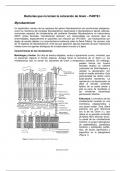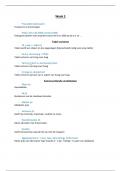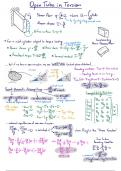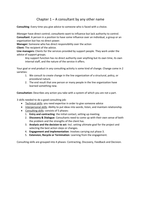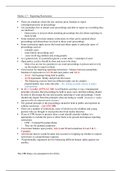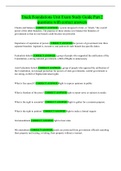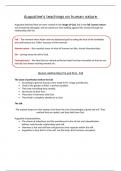structures (Achterberg & Vriens)
Goal: (re-) introduction into designing organizational structures based on the theory by de Sitter 1.
Topics:
(1) What is a structure?
(2) What is an adequate structure?
(3) How to design an adequate structure?
Literature: Book chapter 7.
1
De Sitter (a Dutch organizational theorist) used Ashby to formulate a theory for designing
organizational structures.
Designing adequate organizational structure. Structure is nothing more than the network of tasks.
You need a structure to realize the organizational goals. Goals consist of 1) AV+norms or 2) Quality of
organization (set of variables, efficiency, effectiveness and innovativeness) and 3) quality of work (set
of variables, learning, develop, stress).
A structure that enables you to reach this goals and that you can efficiently to transformational
processes. A structure should also provide that employees can deal with disturbances. Structure
should be not a disturbance. A structure should:
1. Cary out transformational processes
2. Not have disturbances
3. Regulatory potential
When is an particular structure an adequate structure?
- Design parameters should have low values (7 of them OO) this lecture only 4
Make sure that design parameters have low values
Wat are tasks and wat is a network of tasks.
Ad 1 What is an organizational structure?
A structure can be defined as “the way tasks are defined and coupled into a network of tasks”
Mintzberg: the way in which the main task of the organization is broken into subtasks and then
coordinated.
Structure Goals (like EV + norm) or Quality of Work and Quality of Organisation.
Quality of Organisation is about efficiency, flexibility, etc.
Quality of Work has to do with employee involvement, do they experience stress, etc.
1
,Ad. 2 What is an adequate structure?
A structure that enables you to reach this goals and that you can efficiently to transformational
processes. A structure should also make it able to deal with disturbances. And a structure should
include regulatory potential.
De Sitter uses three classes of criteria to evaluate organizational structures – see table.
External functional requirements Internal functional requirements
Quality of order flexibility Short production-cycle time
Organization Sufficient product variations
Variable mix of products
control over order realization Reliable production and production time
Effective control of quality
potential for innovation
Strategic product development
Short innovation time
Quality of work low levels of absenteeism Controllable stress-conditions;
low levels of personnel Opportunities to (1) be involved,
turnover (2) learn, and (3) develop
Quality of workingEffective communication Shared responsibility
relations participation in communication
This table defines de Sitter’s own set of essential organizational variables. He argues: in order to
survive in their environment, organizations should meet certain “external” requirements. And, he
translates these external requirements into “internal” variables that must have certain values so that
the external requirements can be realized.
So for instance, flexibility is an external requirement – if organizations aren’t flexible (cannot react to
changes in demand quickly) then they will perish. To meet this external requirement, de Sitter argues
that (among other things) one should realize short production cycle times (an internal requirement).
The internal requirements (essential variables) can be disturbed in many ways.
E.g.:
If machines have to be set-up for each different batch, cycle time may be longer;
If you produce in large batches instead of small ones (single-piece production) cycle time
may be long;
If machines break down, the production process will be delayed;
people getting sick delays processes
if you don’t have an overview over the process, it is hard to predict how long the total lead
time is, which is problematic for ‘being in control of the production process’
Having no knowledge about the market may be problematic for innovation.
If your job consists of short-cycled tasks, there might not be much to learn and develop –
which may be problematic for the quality of work.
If you face many disturbances but have little regulatory potential, you may feel stressed
(which is problematic for the quality of work)
If you don’t have an overview over the process and don’t know the products you are
contributing to, there seems little point in communicating about your work with others –
which may be problematic for the quality of working relations
…
2
, These are all examples of disturbances for organizational essential variables. Two types of
disturbances can be identified: disturbances that are directly related to the (infra)structure and other
disturbances.
Now, an adequate structure should:
(1) Itself not be a source of disturbances (structure related disturbances should be attenuated)
and, at the same time,
(2) Have requisite regulatory potential (such potential should be amplified)
(3) So as to enable the realization of organizational goals
(Note: this is directly taken from Ashby).
The question now becomes: what kind of structures fulfill these requirements? That’s the topic of the
next section:
Ad 3. Designing an adequate structure.
De Sitter argues: it is possible to design an adequate structure by
“defining and coupling tasks in such a way that so-called design parameters have a low value…”
If he’s right, then it seems to be worthwhile to answer the following questions:
(1) What is a task?
(2) What are design parameters?
(3) What are the “low values” of these design parameters, and how do these values relate to the
adequacy of structures?
You can design this by focusing on Design Parameters. There are 7 Design Parameters. These should
have low values. We will address 4 of them today.
1. The level of functional concentration.
2. The level of separation.
3. The level of specialization of operational transformation’s.
4. The level of specialization of regulatory transformations.
3.1 A task
To give a description of a task, we need to take a look at the following concepts:
(1) A transformation process (transforming input into output);
(2) The idea of decomposing of a transformation. Decomposing a transformation can be done in
two basic ways:
a. Horizontal (aspectual) decomposition – here two new sub-transformations emerge
which cover the whole original transformation, but highlight only a particular aspect
of it (e.g. particular output or input);
b. Vertical (partial) decomposition. Here new sub-transformations emerge that are
coupled serially (each output of one sub-transformation is the input of a next sub-
transformation).
One can apply these two basic decomposition steps to the original transformation repeatedly so that
one ends up with a set of sub-transformations.
(3) Based on the above ideas, one can now define a task as a set of sub-transformations that is
assigned to an “operational unit” (a person, person + machine, team, department, business
unit, …).
(4) In organizations there is one important type of horizontal decomposition that should be
mentioned: separating regulatory sub-transformations from operational ones.
3

